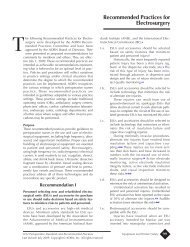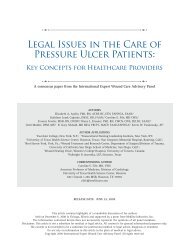2009 CAUTI guidelines - Centers for Disease Control and Prevention
2009 CAUTI guidelines - Centers for Disease Control and Prevention
2009 CAUTI guidelines - Centers for Disease Control and Prevention
You also want an ePaper? Increase the reach of your titles
YUMPU automatically turns print PDFs into web optimized ePapers that Google loves.
1. If obstruction is anticipated, closed continuous irrigation is suggested to preventobstruction. (Category II)I. Routine irrigation of the bladder with antimicrobials is not recommended. (Category II)(Key Question 2C)J. Routine instillation of antiseptic or antimicrobial solutions into urinary drainage bags isnot recommended. (Category II) (Key Question 2C)K. Clamping indwelling catheters prior to removal is not necessary. (Category II) (KeyQuestion 2C)L. Further research is needed on the use of bacterial interference (i.e., bladder inoculationwith a nonpathogenic bacterial strain) to prevent UTI in patients requiring chronic urinarycatheterization. (No recommendation/unresolved issue) (Key Question 2C)Catheter MaterialsM. If the <strong>CAUTI</strong> rate is not decreasing after implementing a comprehensive strategy toreduce rates of <strong>CAUTI</strong>, consider using antimicrobial/antiseptic-impregnated catheters.The comprehensive strategy should include, at a minimum, the high priorityrecommendations <strong>for</strong> urinary catheter use, aseptic insertion, <strong>and</strong> maintenance (seeSection III. Implementation <strong>and</strong> Audit). (Category IB) (Key Question 2B)1. Further research is needed on the effect of antimicrobial/antiseptic-impregnatedcatheters in reducing the risk of symptomatic UTI, their inclusion among theprimary interventions, <strong>and</strong> the patient populations most likely to benefit fromthese catheters. (No recommendation/unresolved issue) (Key Question 2B)N. Hydrophilic catheters might be preferable to st<strong>and</strong>ard catheters <strong>for</strong> patients requiringintermittent catheterization. (Category II) (Key Question 2B)O. Silicone might be preferable to other catheter materials to reduce the risk of encrustationin long-term catheterized patients who have frequent obstruction. (Category II) (KeyQuestion 3)P. Further research is needed to clarify the benefit of catheter valves in reducing the risk of<strong>CAUTI</strong> <strong>and</strong> other urinary complications. (No recommendation/unresolved issue) (KeyQuestion 2B)Management of ObstructionQ. If obstruction occurs <strong>and</strong> it is likely that the catheter material is contributing toobstruction, change the catheter. (Category IB)R. Further research is needed on the benefit of irrigating the catheter with acidifyingsolutions or use of oral urease inhibitors in long-term catheterized patients who havefrequent catheter obstruction. (No recommendation/unresolved issue) (Key Question3)14
















